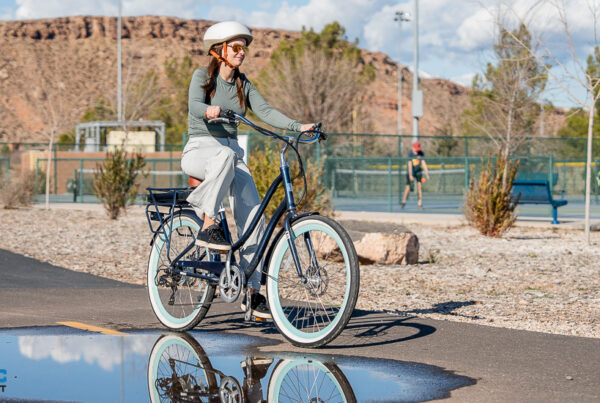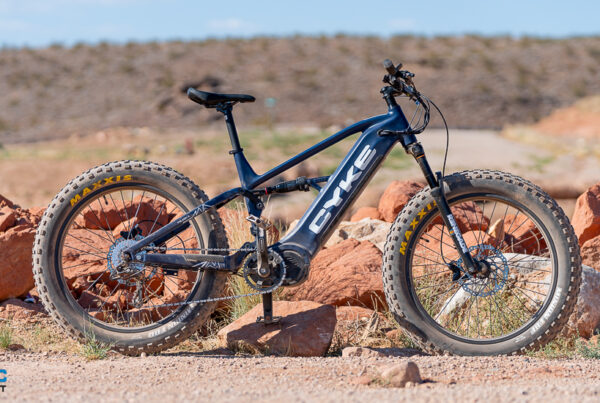Some links may be affiliate links. We may get paid if you buy something or take an action after clicking one of these.
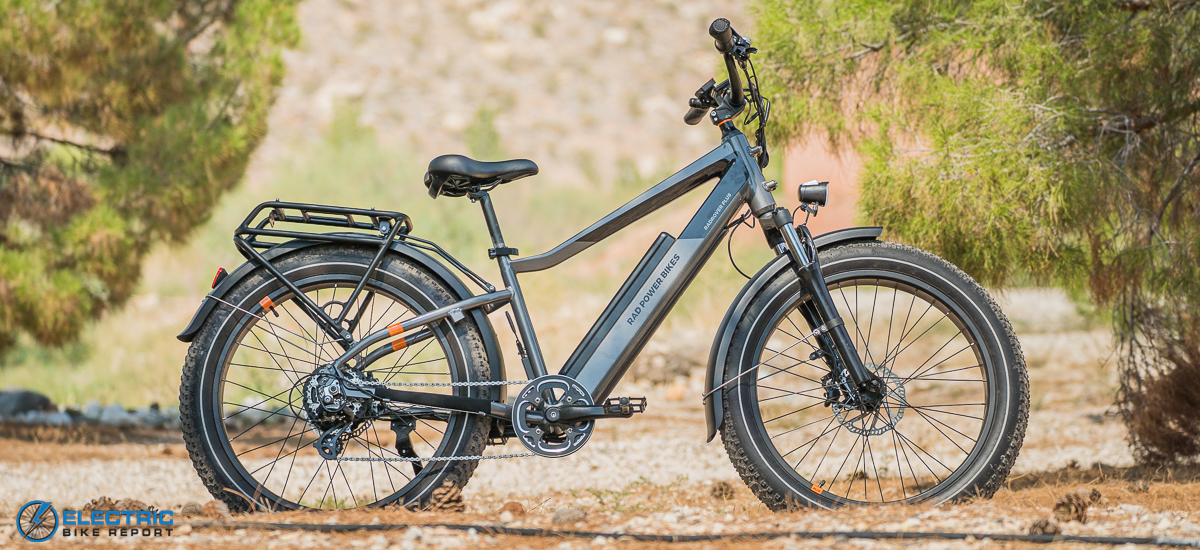
RadRover 6 Plus Review: Overview
The Rad Power Bikes RadRover 6 Plus is a Class 2 fat tire electric bike that’s designed for paved and unpaved joyrides and commutes. The RadRover 6 has enough power to thrive in a town with steep hills and enough comfort to enjoy your evening cruise.
The RadRover 6 Plus holds onto its classic Rover roots while still bringing some new bells and whistles to the table. When we started the RadRover 6 Plus review process we noticed some big changes right out of the box. From the new dual display to the integrated battery pack, the evolution of the RadRover was apparent. Rad claims their RadRover 6 Plus to be “the biggest evolution in RadRover history”.
Looks aren’t everything though, so we conducted a hill climb test, brake test, circuit test and more to get familiar with the changes Rad Power Bikes has made since we reviewed the RadRover 5 earlier this year. By the end of this review you should have a good idea of how the bike performed and if the RadRover 6 is the right fat tire e-bike for you.
Bike Category: Fat Tire/ Hybrid Path The RadRover 6 Plus is a fat tire e-bike that rides smoothly on gravel roads and paved trails.
Bike Class: Class 2Class 2: PAS/Throttle assist up to 20 mph
RadRover 6 Plus Video Review
 Pro’s
Pro’s- The Rovers 750W motor has very smooth engagement and a predictable power output.
- The dual display not only looks cool, but it allows the rider to see more data without cycling through a singular display.
- The RadRover 6 Plus rides very soft over most terrain. The fat tires and suspension fork absorb a lot of vibrations and chatter before they reach the rider.
- Rad Power Bikes’ 6th rendition of the RadRover is the most visually appealing Rover to date.
- The semi-integrated battery pack is very easy to pop in and out of the bike.
 Con’s
Con’s- The secondary display is a little bit dim to see when riding on a bright sunny day.
- The over bar shifter doesn’t fit the theme of the bike well, we feel an under bar shifter would not only improve visuals, but shifting ergonomics as well.
ELECTRICAL SPECS & FEATURES
- Battery: 48V, 14Ah (672Wh)
- Display: LCD display with speedometer, odometer, trip mileage, PAS level and more
- Motor: 750W brushless geared hub motor
- Headlight: Standard LED headlight
- Taillights: Integrated tail light with brake light
- Peal Assist: Pedal assist levels 1-5
- Range: 25-45 miles
- Throttle: Half twist throttle, grip twist, right side
Weight & Dimensions
- Battery weight: 10 lbs
- Claimed weight: 73.4 lbs
- Real weight: 73.4 lbs
- Maximum rider weight: 275 lbs
- Maximum load on rear rack: 50 lbs
- Dimensions: 77” x 45.7” x 27.5” (length x height x width)
Components & Accessories
- Brakes: Nutt hydraulic disc brakes, 180mm rotors front and rear
- Fenderss: Front and rear, plastic
- Fork: 60mm RST spring fork, comes with lockout and preload adjustment
- Frame: 6061 aluminium alloy
- Gearing: 7-speed Shimano Altus , 11-34T
- Grips: Imitation leather, ergonomic grips
- Saddle: Ergonomic seat, lifting handle included
- Handlebar: 700mm wide, 4” rise
- Kickstand: Heavy duty aluminium, plastic foot
- Pedals: Aluminum 9/16”
- Tires: Kenda Juggernaut 26” x 4”, puncture resistant liner
RadRover 6 Plus Performance Review
Acceleration / Speed
The RadRover 6 Plus’ 750W motor engages very smoothly and consistently when accelerating, especially for a hub motor. I am very familiar with the feeling of mid-drive motors and the RadRover’s 750W rear hub motor reminded me of one. Between the smooth engagement, safe levels of acceleration and consistent power output I was really impressed with the motor.
The RadRover 6 ships as a Class 2 electric bike but is adjustable to a Class 3 e-bike for those looking for pedal assist up to 28 mph. A majority of our testing and review process has been done in the Class 2 setting because we try to test the bikes how the manufacturer intended them to be set up, however I haven’t forgotten about my fellow Class 3 lovers so I spent some time with the speed bumped up to 28 mph, too.
Range Test
Here at Electric Bike Report we conduct a battery range test to get a good idea of the true real world range these batteries can provide. We do two separate range tests, one in the highest pedal assist level, the other in the lowest. After the tests are complete we have a good idea of the batteries real world range and performance. We had the RadRover 6 Plus set up as a Class 2 e-bike.
When I conducted the maximum pedal assist test I reached 28.47 miles, with an average speed of 18.3 mph before the RadRover finally died. The bike had no issue hovering around the top speed of 20 mph and I noticed that it held a solid average speed up hills too.
When our test rider Josh tested the Rover in the lowest pedal assist setting he reached 50.49 miles with an average speed of 10.7 mph. We exceeded the claimed range on both the range tests. All things considered, the RadRover 6 Plus can hold onto battery life for a decent amount of time.
Circuit test
The RadRover 6 Pluscomes with 5 total pedal assist levels. To get a good idea of how the pedal assist levels vary from one another we conduct what we call the circuit test — a 1 mile loop that we ride in each pedal assist setting. After the test is completed we can see the power curve the bike we are testing has, we are also able to see how big the jumps are from level to level.
The power of the 750W motor kept the RadRover 6 Plus around the top Class 2 speed with relative ease in pedal assist settings 3, 4 and 5. It’s safe to assume PAS 4, and 5 would yield even higher average speeds if we had the RadRover set up as a Class 3 e-bike.
When it comes to Class 3 settings the RadRover 6 Plus is going to yield similar speeds to RadRover 5, however speed isn’t everything. The RadRover 6 has considerably smoother power engagement because of its new motor and battery. While the speed you’re going may be similar on each bike, it’s going to feel a lot better on the RadRover 6 Plus. On the RadRover 5 we had an average speed of 20.9 mph in PAS 4, and 24 mph in PAS 5.
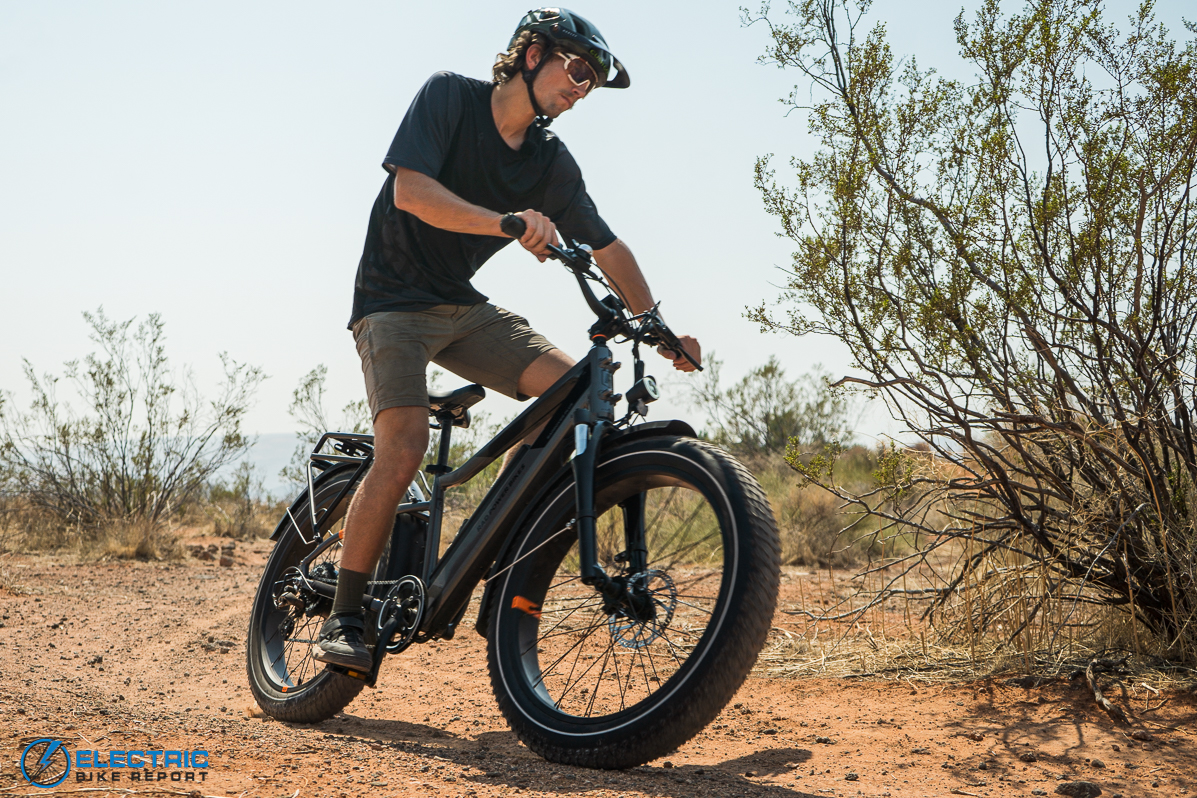
The RadRover 6 has a good amount of off-road capability.
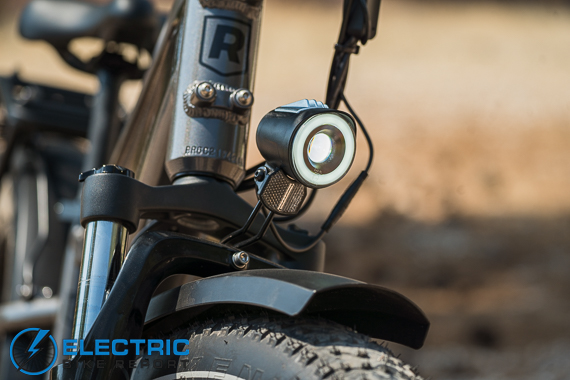
Headlight on the RadRover 6.
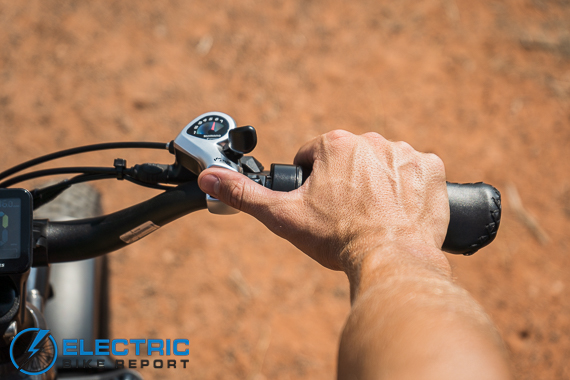
Shifting to a harder gear on the Rover.
Hill Test
One of the biggest selling points of electric bikes is the way they are able to flatten hills. Some e-bikes flatten hills more than others, and we conduct a hill climb test to see how the bikes perform when climbing up one of the steepest hills we can find in our local area of St. George, Utah. We do two separate hill climb tests — one on the highest pedal assist setting and the other using only the throttle.
When I climbed our quarter-mile, 12% to 15% percent grade hill on maximum pedal assist the Rover 6 cleared the top in 1:24 with an average speed of 12.9 mph. And using just the throttle, the Rover made it to the top in 1:48 with an average speed of 10 mph — impressive results from this bike.
Handling
The handling characteristics of the RadRover 6 Plus seem to favor stability above all. I spent a good amount of time riding this bike on-road and off-road and components like the suspension fork and fat tires gave me a good balance point and a plush, truck-like feeling when riding over bumpy terrain. It often felt like I was hovering above the terrain instead of fighting it.
The slightly wider than average 700mm handlebar gives the RadRover 6 Plus additional stability and control that would be hard to find on a thinner handlebar. Considering the weight and all terrain capability of the RadRover 6 Plus I was happy to have these handlebars.
The Kenda Juggernaut tires are a hefty 4-inches wide and have a puncture resistant liner that adds to the off-road prowess of this bike. While I wouldn’t call the RadRover 6 Plus a mountain bike, it certainly feels more capable off-road than the previous Rover.
Ride Comfort/Geometry
The RadRover 6 Plus walks the fine line of maintaining sporty handling characteristics while still being comfortable enough for just about everybody. The handlebar has a 4-inch rise which gives the Rover 6 an upright position that’s great for commuting and cruising. I never had any discomfort in my lower back or neck and I think that’s partially due to the handlebar.
Another comfort-adding component was the ergonomic seat. It’s plenty soft and I was able to distribute my weight comfortably and evenly on the saddle. Its shape and softness made it so I didn’t have to reposition myself much either. The padding holds its form well on longer rides.
The geometry of the RadRover 6 Plus ties together all of the comfort-oriented components in a way that feels seamless and well thought out. Each component feels like it is there for a reason.
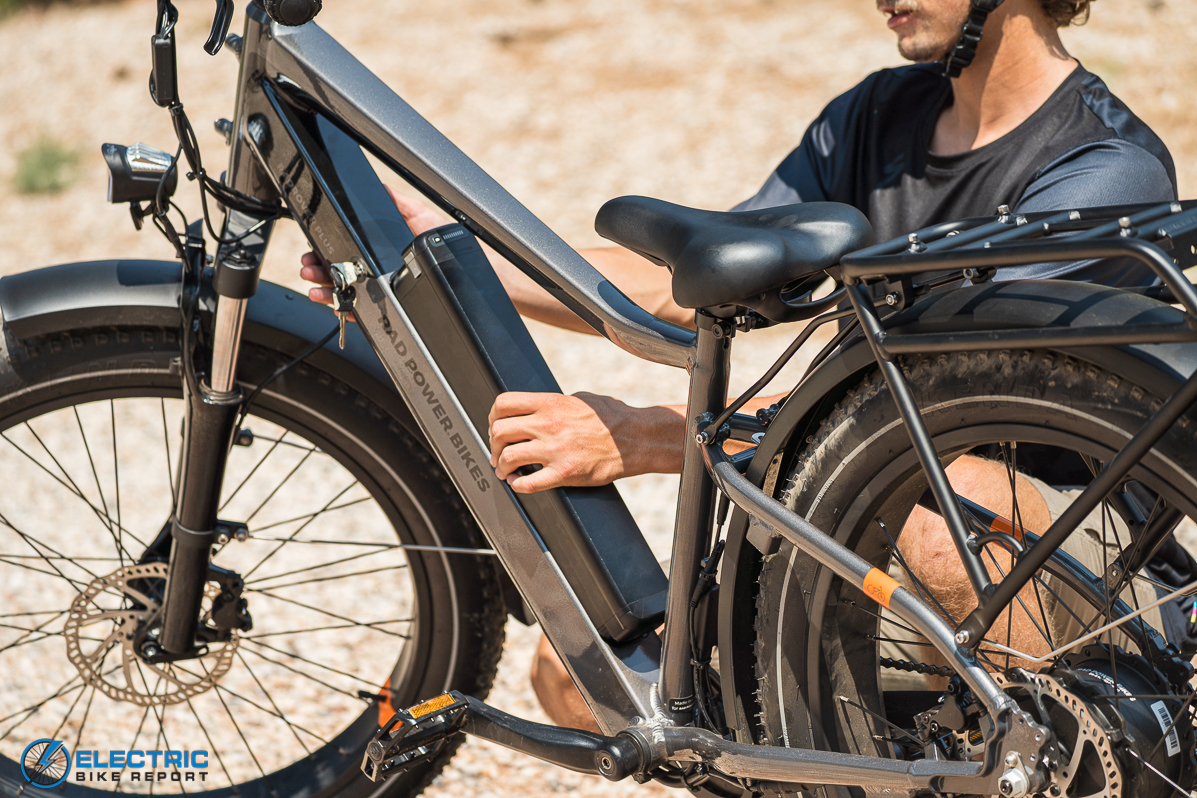
Removing the semi-integrated battery.
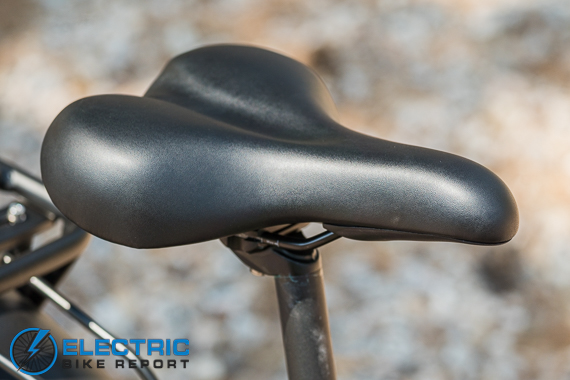
The RadRover 6’s saddle.
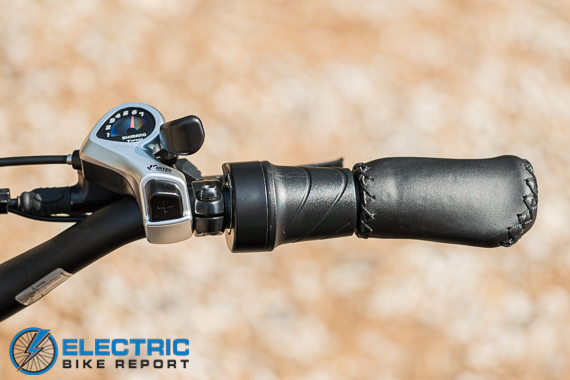
Twist throttle, shifter, and ergonomic grip.
RadRover 6 Plus Specs/Features Review: Electric Components
Motor
The RadRover 6 Plus uses a 750W geared hub motor that offered me smooth engagement consistently. While the motor definitely is capable of quick acceleration and large bursts of power, the way it is calibrated makes for safe levels of acceleration while still being quick enough to get up to speed fast.
The motor has enough torque to take over for riders on steep hills and other areas that would normally cause rider fatigue. I noticed the motor rarely reached its maximum output of 750W, it usually was able to get up steep hills and hover around top speed with around 600-650W.
During our hill test the motor handled the steep grade very well. On the throttle only test it did make a little bit of a “whirring” noise, but it was rare that I dropped below 10 mph. Considering the fact that the Rover weighs over 70 lbs the speed I carried was pretty impressive to me. When the Rover uses all 750W of its power there aren’t a lot of hills it won’t be able to ascend, especially if you’re pedaling.
Regardless of the way you use the RadRover 6 Plus, having some extra wattage in the reserves will be highly beneficial. Steep hills won’t seem as steep, and high speeds won’t be as hard to maintain.
Battery
The 48V, 14Ah battery is integrated nicely into the downtube of the RadRover 6 Plus . Visually speaking, this is one of the areas I noticed the most change from the prior RadRover. The sleek battery pack lasted decently long on our maximum pedal assist range test, where I reached 28.47 miles with an average speed of 18.3 mph.
Because the RadRover 6 Plus is set up as a Class 2 e-bike the average speed was actually quite impressive. My average speed was only 1.7 mph less than what the bike was limited to (20 mph), showing the RadRover 6 Plus had no issue holding on to and maintaining speed.
Based on our test results the battery’s performance is very similar to the previous generations. We found the biggest difference in this generation’s battery pack is mostly visual. With that being said, it was pretty impressive to see a battery of the same size able to fit mostly within the frame of the bike.
Pedal Assist / Throttle
The RadRover 6 Plus comes with 5 levels of pedal assist, each producing more power than the previous level — some jumps bigger than others. Pedal assist level 1 to 2, and 2 to 3 provided very clear power increases; levels 3,4, and 5 did not provide much difference.
The RadRover 6 Plus has a very powerful 750W motor, and is shipped as a Class 2 e-bike. This combination gives the RadRover 6 Plus enough power to easily hover around its top Class 2 speed by the time I was in pedal assist level 3. Levels 4 and 5 kept me around the same speed, with slightly faster acceleration.
If you decide to set up your RadRover 6 Plus as a Class 3 e-bike it’s safe to say that levels 4 and 5 will provide a little more variance and distinguishability than they do now. It’s important to us that we test the bikes as a consumer would receive them, hence our Class 2 testing.
The throttle has very similar characteristics to pedal assist level 3, it has enough power to get you up to top speeds but it doesn’t accelerate quite as fast as pedal assist levels 4 and 5.
Display
The RadRover 6 Plus comes with not one, but two LCD displays mounted on the 700mm handlebar, each with its own features and uses. The center-mounted LCD display is similar to that of a car. It shows your speed, mileage, trip mileage, and live watt-usage.
The secondary display sits on the left side of the handlebar and is mainly used for changing the pedal assist level and showing the battery life. The secondary display also has the power button and headlight button.
Between the two displays I had all of the data I wanted to see when riding, and the only complaints I have involve the brightness of the secondary display. It isn’t the brightest, and when I rode with overhead sunlight it was hard for me to see the screen.
Considering this is the screen that displays the pedal assist level and battery life indicator I think it should be just as bright as the main display. The secondary display also has a hefty load of wires behind it, which look a little messy. It would be good to see a little more tidy cable design to match the stealthy, clean look of the RadRover 6 Plus.
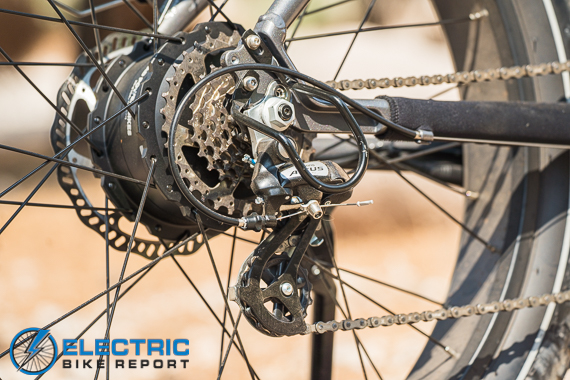
Shimano Altus derailleur and cassette.
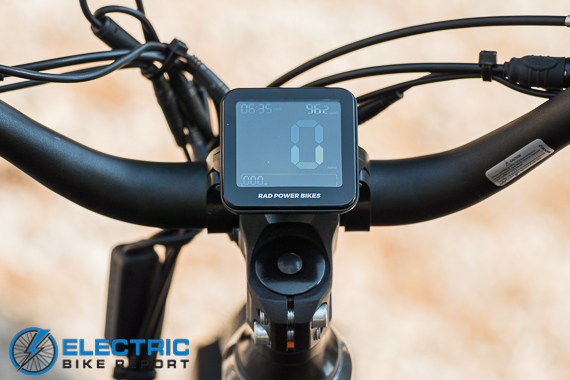
The primary LCD display.
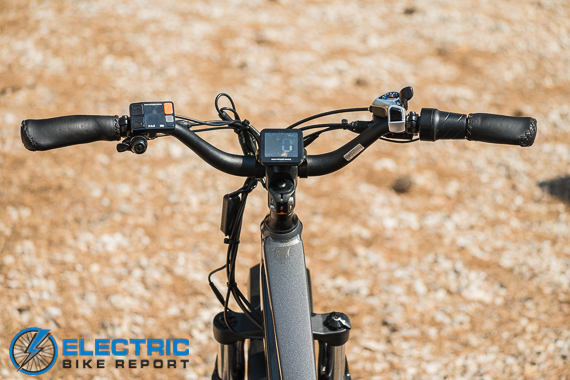
700mm handlebar, full cockpit.
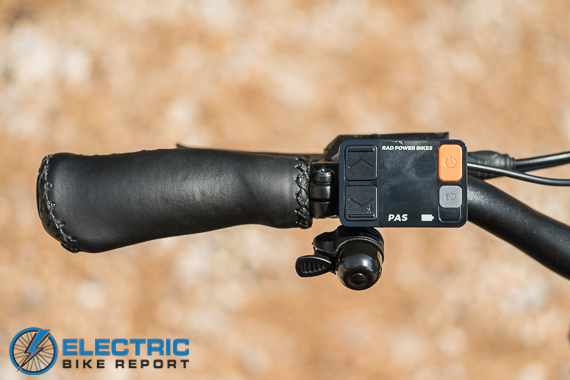
The secondary LCD display.
RadRover 6 Plus Review: Components and Accessories
Even with the best frame in the world, a bike isn’t going to ride well without decent componentry. In this section we dive into each of the RadRover 6’s components, and our impressions of them.
Brakes
The RadRover 6 Plus comes with Nutt hydraulic disc brakes paired with 180mm rotors front and rear. The Taiwan-based Nutt is not a company we were all too familiar with prior to testing the Rover, but after a couple miles I can say these brakes are just fine. They are respectable in all the aspects I look for in a quality set of hydraulic brakes. While they dont shine in any particular category, these brakes had decent power modulation and a solid “bite” when I locked up both the front and rear brake.
During our brake test, we measured the distance it took to come to a complete stop from 20 mph five times. It took 15-feet 4-inches to stop on average.
As far as safety is concerned, these brakes should provide enough power that you’re able to come to a halt within 15 to 20 feet. Keep in mind that different rider weights and skill will create some variance in braking distance.
*** Rad Power Bikes is currently listing their brakes as “Rad Power Bikes approved hydraulic brakes” on their website, which tells me they may be anticipating some brake substitutions depending on parts availability. COVID-19 has caused massive parts shortages in the bike industry, so it’s not uncommon for brands to make substitutions on certain components for others of equal value and performance.
Frame
The RadRover’s 6061 alloy frame got a huge makeover on the RadRover 6 Plus. Between the glossy charcoal paint job, extremely low profile welds and ability to house a battery the new Rover is no doubt easy on the eyes.
The Rover’s redesigned frame is a fresh take on the classic fat tire e-bike, one that was likely needed. The fat tire e-bike category has gotten more competitive over the past year, with more companies releasing sleek bikes with hidden batteries. We think Rad did the Rover justice with its new look.
Fork
The RadRover 6 Plus comes with a 60mm RST spring suspension fork that includes a lockout and preload adjustment. I was pretty surprised to see less suspension travel than on the previous RadRover model, which had 80mm of travel.
When looking through the specifications on the Rover 6 I wondered why this was the case, and then I had the opportunity to ride the bike. As odd as it may sound, the smaller suspension fork actually made the RadRover 6’s front end feel better than its predecessors did.
After discussing this with my fellow Electric Bike Report reviewer and writer Sam Gross we chalked this up to stanchion size. Less travel actually favors the performance of the RST spring fork because there is less unwanted flexing because of a smaller stanchion length.
To those who aren’t familiar with bike-industry terminology and vocabulary; the longer a stick, the easier it is to flex, bend or break. It’s the same thing with suspension forks.
Drivetrain / Shifting
The RadRover 6 Plus comes with a 7-speed Shimano Altus drivetrain paired up with a 42T chainring. The Rover’s gear ratio makes for a good hill climbing bike that easily maintains high speed on flat ground. In simpler terms, the gear range compliments the Rover’s uses nicely because it gives a wide gear range.
The Shimano Altus drivetrain uses a Shimano thumb shifter which sits on top of the right side of the handlebar. While this shifter provides crisp, consistent shifts I would much prefer an under bar shifter.
Under bar shifters require less effort and thinking to use. They also are a little easier to shift quickly with. With the rest of the RadRover 6 Plus taken into account, I think the shifter style and placement is an area that could use some improvement.
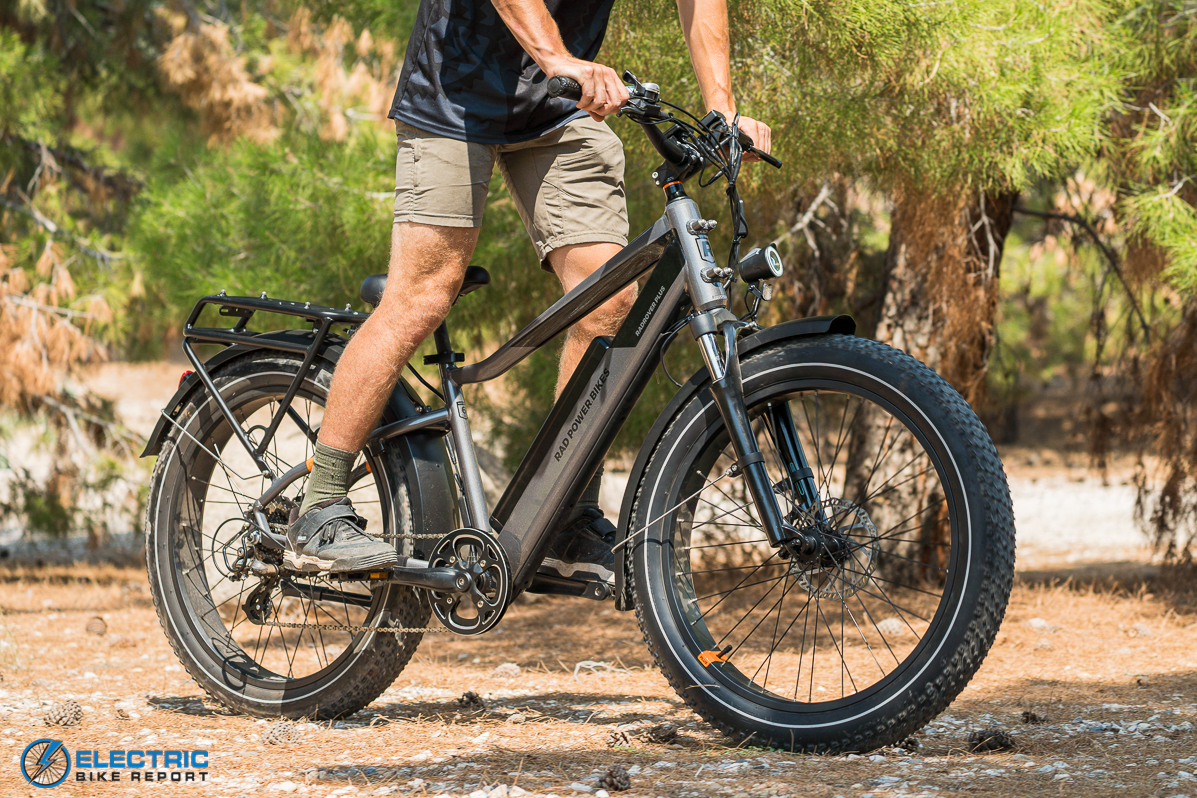
Prowling through some pine needles on the RadRover 6

Rear hydraulic brake rotor and caliper
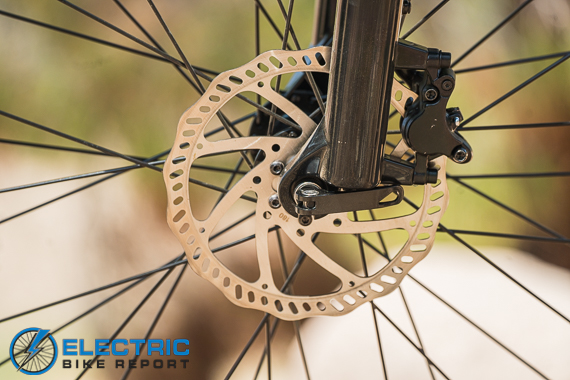
Front hydraulic brake rotor and caliper
Contact Points / Comfortability
I was plenty comfortable on the RadRover 6 Plus.
Rad Power Bikes did a good job of designing the Rover to be comfortable, but still capable of performance oriented riding. The ergonomic saddle, grips, high rise handlebars, suspension fork and fat tires made for a very soft riding e-bike.
Bumps and cracks in the road were absorbed by the bike resulting in less fatigue throughout the span of my ride. The level of comfort the RadRover 6 Plus has will be good for cruisers, commuters and recreational riders alike.
Tires
The Kenda Juggernaut 26” x 4.0” tires suit the Rover nicely. The grippy and versatile tread pattern combined with the puncture resistant liner makes for a set of capable tires that inspires confidence and improves control.
These tires also hold a lot of air, which allowed me to mess with different pressures which ended up yielding their own performance benefits.
The higher the pressure I ran the faster rolling the Rover was on paved surfaces. The lower the pressure I ran the better the Rover was at maintaining traction on looser terrain, such as sand and gravel. Despite the lower pressures the tires never punctured.
Extras / Accessories
The RadRover 6 Plus comes with a couple of accessories like the headlight, taillight and full coverage fenders. The Rover also has a multitude of extras and accessories that are available on Rad Power Bikes’ website. Rad Power Bikes has listed all the main accessories for the RadRover 6 Plus on its web page.
We’ve been using the RadRover Rear Rack, and the Battery Travel Case throughout the review process. Those are only a couple examples of the available options that are available for purchase on their site.
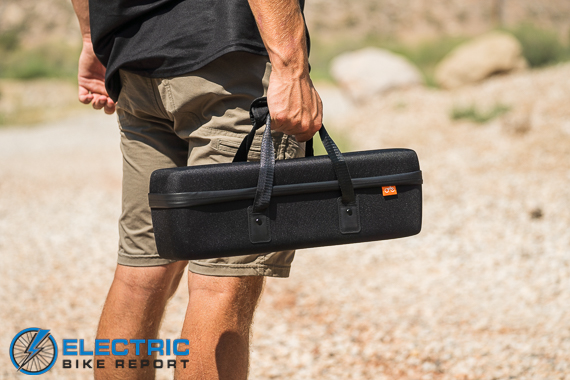
Walking with the battery travel case.
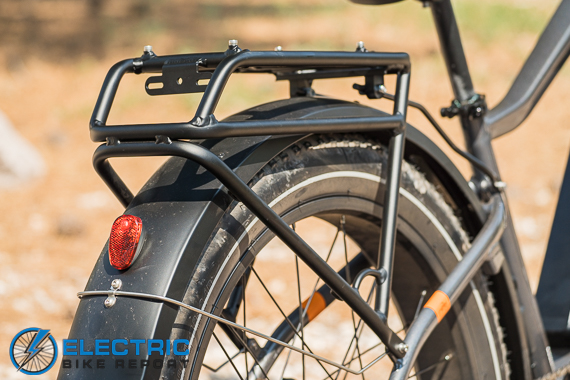
Rear storage rack, fender, and tail light.
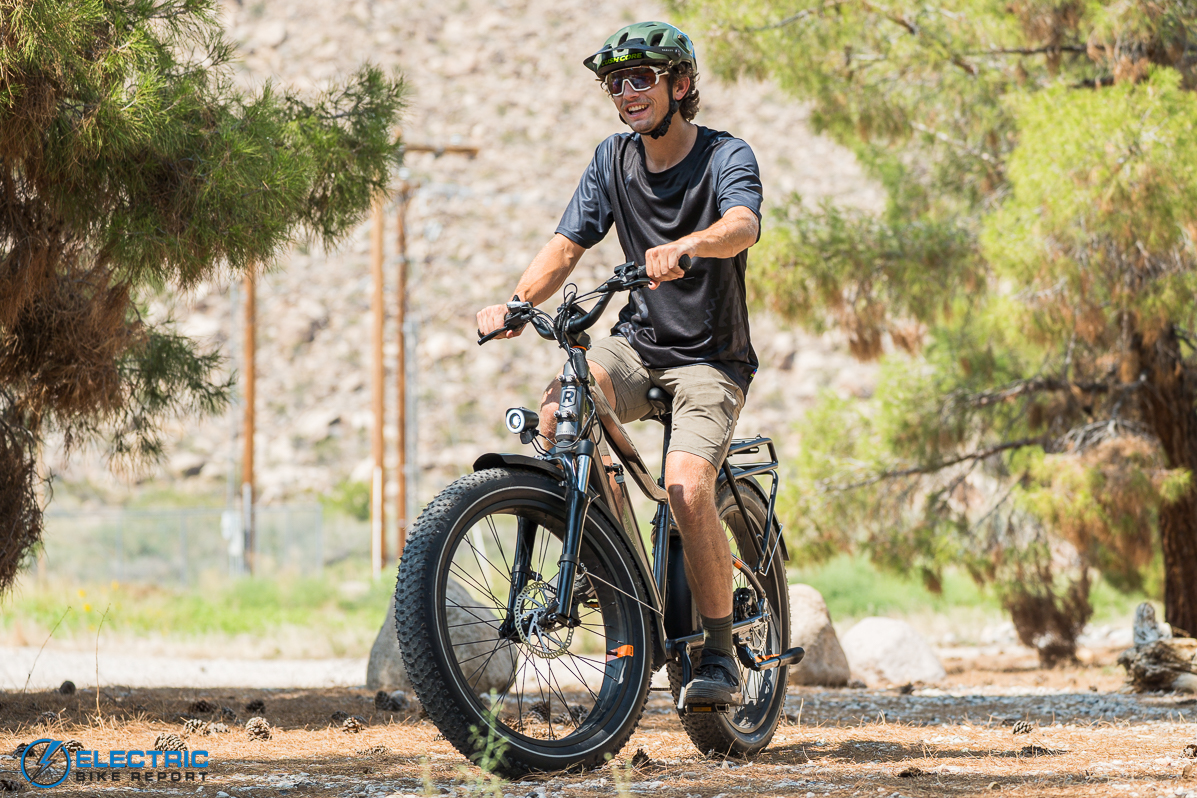
Experiencing the RadRover 6’s off-road capabilities
RadRover 6 Plus Review: Summary / Where to Buy
Rad Power Bikes flagship model, the RadRover 6 Plus proved its worth and capability to us throughout our time spent on it. I was really impressed with the performance of the battery and motor.
While the battery pack may have the same capacity as the previous Rovers it looks loads better. It was a lot easier to remove and replace the battery pack than on previous models. The motors tuning was noticeably smoother than on prior models, it really felt like the motor engagement was in sync with my pedal strokes; something that can’t be said for every rear hub driven e-bike.
It’s clear a lot of thought process and development went into the RadRover 6. From the mentioned motor engagement to the smaller controller and dual display it is apparent that Rad Power Bikes dedicated a lot of time to make the RadRover 6 a standard setter in the fat-tire e-bike world.
The Rover is set up in such a way that makes it extremely versatile. It isn’t good for one particular type of consumer, it’s good for a lot of them. That’s mainly due to the way Rad was able to create a comfortable, yet capable fat-tire e-bike. Take the 700mm wide, 4-inch high rise handlebars for example. The width of the bar is great for stability and control while the 4-inch highrise allows riders to sit more upright; resulting in a more comfortable and enjoyable ride.
The RadRover 6’s paint job was also very easy on the eyes, and once I figured out the Rover can back up its looks with its performance I was eager to write this review. The current competition within the bike industry is forcing companies to be at their best at all times. The RadRover 6 is the product of this hard work.
‘Happy Riding, make sure to let us know if you have any questions down in our comments section or if you think we left anything out in this review of the RadRover 6 Plus.
Reader Interactions
![]()
Source link







